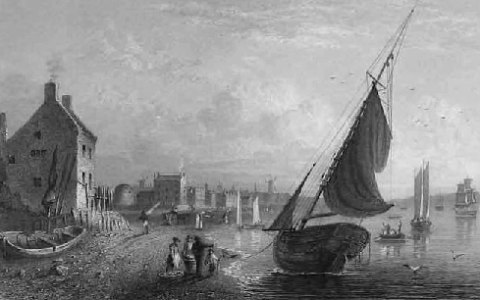利物浦

2007年,利物浦迎来了它的800岁生日,现在伟大的城市港口利物浦实际上是从英格兰西北部默西河潮汐岸边的一个小渔村演变而来的。 它的名字可能也是由以下术语演变而来的 寿命长的人 意思是泥泞的水池或水坑。
利物浦的规模甚至不足以在1086年的《多姆塞德书》中被提及,但当约翰国王在1207年授予其皇家宪章时,利物浦似乎又焕发了生机。 约翰需要在英格兰西北部建立一个港口,他可以从那里迅速派遣人员和物资渡海,以加强他在爱尔兰的利益。 除了港口,每周的市场也开始运作,当然吸引了来自整个地区的民间人士来到利物浦;甚至还建造了一座小城堡。
1229年授予利物浦民间的另一份特许状允许利物浦的商人有权将自己组成一个行会。 在中世纪的英国,商人行会有效地管理着城镇,利物浦的第一位市长是在1351年选出的。
据估计,到14世纪,中世纪利物浦的人口约为1,000人,其中许多人是农民和渔民,还有屠夫、面包师、木匠和铁匠等商人,支持着这个微小但不断增长的定居点。

在接下来的几个世纪中,利物浦开始发展其作为贸易港口的声誉,主要从爱尔兰进口动物皮毛,同时出口铁和羊毛。
See_also: 福克兰群岛16世纪和17世纪初,大量的英国军队在被运往爱尔兰镇压叛乱之前驻扎在该地区,这给利物浦带来了财政上的推动。 1600年时,利物浦还是一个相对较小的城镇,人口仅有2,000。
1642年,忠于国王的保皇党人和议会之间的英国内战开始了。 在多次易手后,利物浦遭到了攻击,最终在1644年被鲁珀特王子率领的保皇党军队洗劫一空。 许多镇民在战斗中丧生。
利物浦只在保皇党人手中停留了几个星期,1644年夏天,他们在马斯顿摩尔战役中被击败。 战役结束后,议会党人获得了对英格兰北部大部分地区的控制,包括利物浦。
17世纪末,随着英国在北美和西印度群岛殖民地的发展,利物浦开始迅速扩张。 利物浦在地理上处于有利地位,可以与这些横跨大西洋的新殖民地进行贸易,该镇也因此繁荣起来。 新的石头和砖块建筑在该镇涌现。
一位17世纪的编年史家记录道:"这是一个非常富有的贸易城市,房屋都是砖石结构,建得很高,甚至于一条街看起来都非常漂亮......有很多人衣着光鲜,很时髦......它是伦敦的缩影,就像我见过的一样。 有一个非常漂亮的交易所......一个非常漂亮的市政厅。

这种大规模的增长和繁荣主要是由西印度群岛、非洲和美洲之间臭名昭著的糖、烟草和奴隶的三角贸易支付的。 由于处于利用这种跨大西洋贸易的战略位置,利物浦很快成为世界上发展最快的城市。
主要来自爱尔兰和威尔士的新移民被迫生活在可怕的条件下,房屋拥挤不堪,没有下水道。
1775年开始的美国独立战争使利物浦与殖民地的贸易一度中断。 美国私掠者甚至开始袭击与西印度群岛贸易的英国商船,捕获船只并没收其货物。
See_also: 民俗年--三月虽然利物浦的第一个码头建于1715年,但随着利物浦发展成为仅次于伦敦和布里斯托尔的全国第三大港口,18世纪又增加了四个码头。 作为离曼彻斯特最近的港口,利物浦也从兰开夏郡棉花工业的发展中大大受益。
到1851年,利物浦的人口达到30多万,其中许多人包括逃离1840年代马铃薯饥荒的爱尔兰移民。
1861年至1865年美国内战爆发后,利物浦对奴隶贸易的依赖程度下降。 另一方面,制造业蓬勃发展,特别是在造船、制绳、金属加工、炼糖和机器制造等领域。
在建造了几个新码头之后,利物浦在本世纪末成为了伦敦之外的英国最大的港口。 曼彻斯特船运河于1894年完工。
 利物浦日益增长的财富反映在整个城市出现的许多令人印象深刻的公共建筑和结构上,包括建于1849年的爱乐厅、中央图书馆(1852年)、圣乔治厅(1854年)、威廉-布朗图书馆(1860年)、斯坦利医院(1867年)和沃克艺术馆(1877年)等等。 斯坦利公园于1870年开放,塞夫顿公园于1872年随后开放。
利物浦日益增长的财富反映在整个城市出现的许多令人印象深刻的公共建筑和结构上,包括建于1849年的爱乐厅、中央图书馆(1852年)、圣乔治厅(1854年)、威廉-布朗图书馆(1860年)、斯坦利医院(1867年)和沃克艺术馆(1877年)等等。 斯坦利公园于1870年开放,塞夫顿公园于1872年随后开放。
利物浦于1880年正式成为一个城市,此时其人口已超过60万。
在世纪之交,有轨电车被改装为电力驱动,利物浦一些最具标志性的建筑也被建成,包括利物浦大厦和库纳德大厦。
二战期间,利物浦作为一个战略港口和活跃的制造业中心,显然是一个目标,它成为英国第二大被轰炸的城市。 近4000人丧生,城市的大片地区变成了废墟。
"如果你想要一座大教堂,我们还有一座...... "罗马天主教大教堂于1967年被祝圣,圣公会大教堂于1978年竣工。
利物浦在20世纪70年代和80年代的全国性经济衰退中遭受重创,出现了高失业率和街头骚乱。 然而,从20世纪80年代末开始,这座城市开始反弹,新的增长和重建,特别是码头地区的重建,给这座城市带来了活力。 一些新的博物馆已经开放,以庆祝城市的历史和遗产,2008年,利物浦人和苏格兰人都当利物浦成为欧洲文化之都时,他们共同庆祝。
博物馆 s
到达这里
利物浦的公路和铁路交通都很方便,请尝试我们的英国旅游指南了解更多信息。

